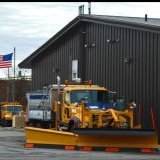-
Posts
2,147 -
Joined
Content Type
Profiles
Blogs
Forums
American Weather
Media Demo
Store
Gallery
Posts posted by MGorse
-
-
34 minutes ago, JTA66 said:
It crashed my Commodore 64.
Come on now, that computer back in the day was sweet!
-
 3
3
-
 1
1
-
-
12 minutes ago, Kevin Reilly said:
Gurantee that sharp cut off down in central Delaware and South Jersey will be right through my backyard in central Delaware County.
You can lock that in!

-
 1
1
-
 1
1
-
-
30 minutes ago, Voyager said:
I got exactly 2 inches in Tamaqua.
Not bad at all.
-
 1
1
-
-
15 minutes ago, penndotguy said:
I’m in Western Berks I got .3 myself
Less than your anticipated 0.5 inches.

-
 1
1
-
 1
1
-
-
The 0.3 inches of snow I got vanished rapidly by mid-morning. Looks like some of the guidance that was hinting at a bit more snow (1 to near 2 inches) across parts of eastern PA panned out.
-
 3
3
-
-
I had a period of snow grains a little while ago while shoveling and it put down a fresh coating. Came in and looked at the radar and was like well now. Snowing decently under that as it moves my way?
-
 1
1
-
-
41 minutes ago, Lady Di said:
Saying this nicely, but we weren't even close to warning criteria despite being issued one.
Yup, that certainly did not pan out.
-
 2
2
-
-
42 minutes ago, Ralph Wiggum said:
So another overhyped storm for SE PA by local TV news outlets?
I thought the NWS Mount Holly @MGorse did a great job tho.
We try our best.
-
 1
1
-
 2
2
-
-
1.8 inches at PHL as of 1 PM.
-
 5
5
-
-
1 hour ago, Violentweatherfan said:
It’s gotta be an intern running the GFS and just having a good laugh.
My bad, hit the wrong button.

-
 7
7
-
-
3 minutes ago, penndotguy said:
Man I’m watching that radar the northern precipitation shield seems to be drying up as it moves east into west Va, would be hilarious if it ran the Mason Dixon line
At least some of the models have been showing that as the precipitation shield initially runs into a much drier air mass. It will saturate, give it time.

-
 1
1
-
 1
1
-
 2
2
-
-
58 minutes ago, Violentweatherfan said:
Would it be strong enough to overcome the dry air from the confluence.
It is possible, but it also may just tighten the northern gradient from snow to no snow.
-
 1
1
-
 1
1
-
-
I have some concern regarding the east-west FGEN zone that the guidance is showing. I have seen this end up being a bit farther north than what the model consensus shows, plus SLR's tend to be higher. We shall see.
-
 7
7
-
 1
1
-
-
4 hours ago, kickingupastorm said:
Winter Storm Watch down graded to a Winter Weather Advisory. What a joke. Ardmore, Montgomery Country.
Technically it is upgraded. Watches cannot be downgraded, just upgraded or cancelled. Just FYI.
-
 2
2
-
 1
1
-
-
1 minute ago, Kevin Reilly said:
Thought blue areas were requiring 4” T remembering from distant past off the top of my head?
The blue area is 5 inches. Increased from 4 inches several years ago. The red area is 6 inches. This is for warning criteria.
-
 1
1
-
 2
2
-
-
10 minutes ago, yankeex777 said:
Does kuchera take into account cold temps aloft?
I came across this explanation: The Kuchera ratio can be especially useful when temperatures are close to freezing, as it can correctly reduce snowfall estimates below 10:1. However, the Kuchera ratio is not perfect, as the true snow-to-liquid ratio (SLR) depends on many factors, including cloud and precipitation physics.
-
 2
2
-
 3
3
-
-
7 minutes ago, anthonyweather said:
Hrrr is way north
Quite the wide swath of snow as well, although it is still showing a zone of heavier snow near and south of Philly.
-
 1
1
-
 1
1
-
-
3 minutes ago, penndotguy said:
Nope I’m not doing it, outside of 5 days, ahh who am I kidding I might peek at it

You know you want to look at it.

-
 1
1
-
 2
2
-
-
25 minutes ago, MillvilleWx said:
I believe the GFS runs on the FV3 core and is fairly hi-res compared to what it used to be. RGEM runs at a resolution similar to the NAM with the HRDPS the Canadian version of the hi-res 2.5km, although it has some significant issues with a multitude of parameters. This is a great question for the MDL people since they have more of the background.
From what I have read, the NWS chose the FV3 as the new GFS's (and GEFS) dynamical core in part because it uses less computer resources than other options.-
 1
1
-
-
Just measured 0.4 inches. Just some flurries now and temperature down to 31.
-
 3
3
-
-
Snowing pretty good here and it did not take long for the grass, mulch and roofs to get a coating of snow. Temperature down to 32.
-
 1
1
-
-
12 minutes ago, RU848789 said:
Thanks!! I tried looking through that website before and just now and maybe I'm just dense, but I couldn't find anything on the time lag nature of the inputs into the NBM, but I'll certainly take your word for it. A time lag definitely explains how the NBM output at a particular time can look more like the output from the models from 6 hours earlier rather than the models that run somewhat concurrently with that time, assuming that the NBM is not including those concurrent runs. And yes I do realize the shorter term/high res guidance does start getting incorporated as one nears an event.
I had to search some but hopefully this is what you are looking for…
https://vlab.noaa.gov/documents/6609493/7858320/NBMv4.1NWPMatrix.pdf
-
2 hours ago, RU848789 said:
A couple of folks on 33andrain, including one met, have said that the NBM is time lagged, i.e., the 07Z NBM would only include model inputs through 0z and not the 06Z models. That would at least explain why the NBM snowfall for 07Z is greater than the 01Z NBM for areas N of Philly and much greater than the 06Z models would suggest, since they're generally much lower than the 0Z models were. To me, that makes the NBM a much less useful tool, if that's correct, as it would always be 6 hours behind.
@MGorse- sorry to tag you again, but can you clarify if this is the case, i.e., what time model inputs go into a particular NBM run? I'd also be curious (see the quoted post) if the 12Z WPC QPF output is simply the 07Z NBM QPF field (they're identical), which is based on 0Z model data - that seems to be very old data, then.
The NBM is time lagged. If there is a notable pattern change in the guidance and even a trend then the NBM will take time to catch up. Closer in time, the NBM incorporates the high resolution guidance which can lead to a noticeable change in the output.
More info about the NBM is available here:
https://vlab.noaa.gov/web/mdl/nbm
-
 3
3
-
 1
1
-
-
27 minutes ago, Ralph Wiggum said:
We were about to get NAM'D good but the run ended
Just extrapolate it.

-
 1
1
-



E PA/NJ/DE Winter 2024/25 Obs/Discussion
in Philadelphia Region
Posted
Rain is needed though given the ongoing drought.